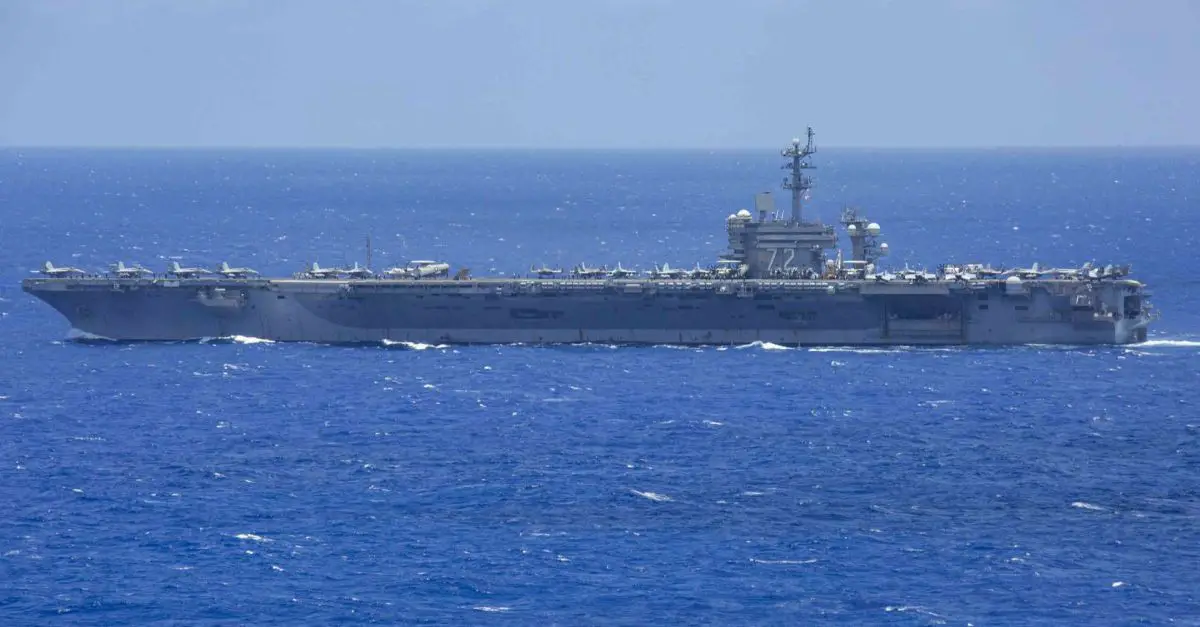Breaking News
Breaking News: US to Increase Naval Military Presence in Middle East Amid Rising Tensions.
In response to increasing threats from Iran and its allied militias, the United States Department of Defense announced on August 2, 2024, a new major deployment of naval military capabilities to the Middle East. This decision comes as a response to escalating threats from Iran and Iranian-backed militias, underscoring the heightened tensions and geopolitical complexities in the area.
Follow Army Recognition on Google News at this link

The Nimitz-class aircraft carrier USS Abraham Lincoln (CVN 72) sails in the Pacific Ocean. Abraham Lincoln, flagship of Carrier Strike Group Three, is underway conducting routine operations in the U.S. 3rd Fleet area of operations. (Picture source: U.S. DoD)
According to a statement released by the Pentagon on August 2, 2024, the U.S. will deploy additional defensive military capabilities to safeguard American troops and bolster Israel's defenses. The deployment will include cruisers and destroyers equipped with ballistic missile defense systems, along with an additional squadron of fighter jets.
Deputy Pentagon Press Secretary Sabrina Singh highlighted the urgency of the deployment, citing threats from Iran and Iranian-backed groups as the primary catalyst. She emphasized that the move aligns with the U.S.'s commitment to defending its allies, particularly in light of recent hostilities.
The announcement follows high-level discussions between President Joe Biden and Israeli Prime Minister Benjamin Netanyahu. The conversations aimed to reaffirm the United States' steadfast support for Israel, especially after the October 2023 Hamas attacks and subsequent Iranian-backed strikes. Secretary of Defense Lloyd J. Austin III further solidified these commitments in discussions with Israeli Defense Minister Yoav Gallant.
Citing information from The Washington Post, the USS Theodore Roosevelt was stationed in the Persian Gulf on Wednesday, accompanied by six U.S. Navy destroyers: the USS Cole, the USS John S. McCain, the USS Daniel Inouye, the USS Russell, the USS Michael Murphy, and the USS Laboon. Meanwhile, in the eastern Mediterranean, the three amphibious ships—USS Wasp, USS Oak Hill, and USS New York—are positioned alongside two destroyers, the USS Bulkeley and the USS Roosevelt. This consistent U.S. naval presence underscores a strategic approach to maintaining readiness and response capabilities.
The USS Wasp and USS New York, part of the amphibious ready group, are equipped with a Marine Expeditionary Unit poised for rapid deployment should evacuation of U.S. personnel become necessary. Additionally, a U.S. official, speaking on condition of anonymity, confirmed that two destroyers currently in the Middle East will move northward through the Red Sea towards the Mediterranean. At least one of these vessels is expected to remain in the Mediterranean if the situation demands, further enhancing the U.S. Navy's strategic posture in the region.
In addition to air deployments, the U.S. Navy is making strategic moves to maintain its presence in the region. The aircraft carrier USS Dwight D. Eisenhower (CVN-69) has exited the Red Sea, while the USS Theodore Roosevelt (CVN-71) is set to leave the Pacific for the Middle East to uphold a U.S. presence mission. The USS Abraham Lincoln (CVN-72) will soon relieve the Roosevelt, ensuring continued American naval strength under U.S. Central Command.
Moreover, the three-ship Wasp Amphibious Ready Group (ARG), along with the 24th Marine Expeditionary Unit, is currently positioned in the Eastern Mediterranean. This group stands ready to execute a potential non-combatant evacuation from Lebanon, highlighting the U.S.'s preparedness for various contingencies.
The U.S. military's intensified presence comes on the heels of a successful defense against a massive Iranian attack on April 13-14, when U.S. Air Force fighters intercepted over 80 drones targeting Israel. The attack was part of a broader offensive involving approximately 300 missiles and drones, with significant defensive contributions from Israel and coalition partners.
U.S. forces, including F-15Es from the 494th Fighter Squadron and F-16s, played a pivotal role alongside coalition fighters and naval assets. Despite the threat from Hezbollah's extensive arsenal in Lebanon, U.S. and allied forces demonstrated robust defensive capabilities.
The U.S. DoD statement also highlighted plans to increase land-based ballistic missile defense readiness, underscoring the U.S.'s ongoing commitment to regional stability. As tensions with Iran and its allies persist, the deployment marks a critical step in fortifying defenses and reassuring partners in the Middle East.


























